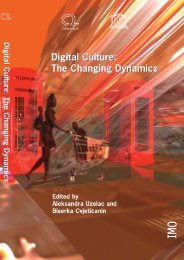free download in pdf format - Culturelink Network
free download in pdf format - Culturelink Network
free download in pdf format - Culturelink Network
You also want an ePaper? Increase the reach of your titles
YUMPU automatically turns print PDFs into web optimized ePapers that Google loves.
Cultural policies, identities and monument build<strong>in</strong>g <strong>in</strong> Southeastern Europe<br />
“Gratitude” strategy vs. strategy of oblivion<br />
A specifi c part of monument policy was to realize it through a strategy of gratitude,<br />
and this is a tradition <strong>in</strong> south-Slavic countries as part of their “civil society eff orts”. 10<br />
Th e fi rst monument to Tolstoy outside Russia was erected <strong>in</strong> the village of Selce (Brač,<br />
Croatia) <strong>in</strong> 1907, as a sign of Slavic identity and resistance towards Italianization. It<br />
is specifi cally gratitude to the great Slavic writer for keep<strong>in</strong>g Slavic nations respected,<br />
although oft en considered “non-historical” (depriv<strong>in</strong>g them of their rights for<br />
<strong>in</strong>dependence and autonomous development).<br />
Th e Monument of Gratitude to France <strong>in</strong> Belgrade, monuments to diff erent French<br />
generals (e.g. Franchet d’Esperey), and the nam<strong>in</strong>g of streets aft er personalities who had<br />
helped Serbia <strong>in</strong> the First World War to be recognized as a w<strong>in</strong>ner (such as the Swiss A.<br />
Reiss and the Greek Prime M<strong>in</strong>ister Venizelos) or had helped <strong>in</strong> war eff orts (Scottish<br />
nurses such as Dr E. Inglis, B. McGregor, F. Sandes) and so forth, were part of a strategy<br />
to realize state memory (monument) policy.<br />
Th is tradition had cont<strong>in</strong>ued <strong>in</strong> the new states. In the same village where the<br />
monument to Tolstoy was erected now lie monuments to Tuđman, Austrian Premier<br />
Mock and the German M<strong>in</strong>ister of Foreign Aff airs H. D. Genscher. Th is confi rms the<br />
statement about Western biased foreign policies (which before negotiations and the war<br />
took a clear stand). Th e monument to Cl<strong>in</strong>ton <strong>in</strong> Prišt<strong>in</strong>a refl ects the perception of the<br />
population of Southeastern Europe of the importance of the foreign factor. Th e fi lm<br />
Fuse/Gori vatra, by Pjer Žalica, Bosnia and Herzegov<strong>in</strong>a 2004, described those feel<strong>in</strong>gs<br />
(with an ironic distance towards “gratitude”).<br />
Th e model of dissent – creative dialogue<br />
Th e only ones who had the courage to redefi ne relations towards the cultural heritage<br />
of the Socialist Federal Republic of Yugoslavia, apart from the eff orts of the Yugonostalgic<br />
diaspora (those who emigrated refus<strong>in</strong>g to participate <strong>in</strong> the division of the<br />
country), were artistic circles. With their concepts and visions, they confronted the<br />
anachronistic monument policies of Southeastern Europe, conservative and retrograde<br />
as they were, neglect<strong>in</strong>g the heritage of modernism.<br />
In this spirit Mrđan Bajic created a series of virtual monuments for the YugoMuseum.<br />
Inspired by the artefacts, events and myths which created but also destroyed Yugoslavia,<br />
Mrđan Bajic explored the hidden memories of both Tito’s and Milošević’s time. Each<br />
Bajić virtual sculpture is a monument which memorializes crucial events lead<strong>in</strong>g<br />
towards the civil war and the dissolution of the country. Th e Memorandum monument<br />
10 Philanthropy was focus<strong>in</strong>g national identity: merchants and rich citizens of Slavic orig<strong>in</strong><br />
gave money for theatres, as well as for monuments, such as the Monument of the Four Faiths,<br />
constructed <strong>in</strong> Čačak <strong>in</strong> 1930 and devoted to soldiers of four faiths (Christian: Orthodox and<br />
Catholic, Jewish and Islamic) killed <strong>in</strong> the First World War.<br />
41



